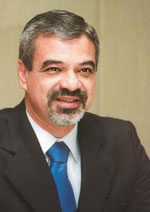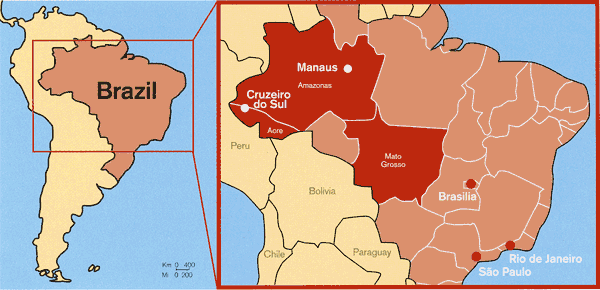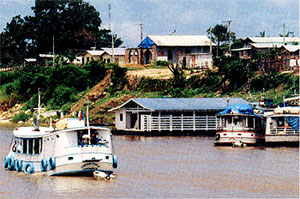|
REPORT FROM BRAZIL
Brazil Turns Over a New Leaf
The present government is determined to make up for lost time in the battle to eliminate leprosy.
Brazil is second only to India in having the most cases of leprosy in the world.
As of January 1, 2004, Brazil had 79,908 registered cases and a PR of 4.52/10,000 persons, according to official government statistics. Of that number, 49,026 were new cases detected in 2003.
By state, Mato Grosso has the highest PR at 22.11, and five of Brazil's 27 states have a PR of over 10. The northern part of the country has an average PR of over 11.44.
Since 1999, treatment of leprosy has been fully integrated into the general healthcare system. The target for eliminating leprosy has been set at 2005 at the national level, and 2010 at the municipal level, with activities focused on the following seven areas: 1) identifying and treating patients; 2) developing human resources; 3) drawing up an effective elimination strategy; 4) giving complete treatment; 5) reforming the information system on leprosy; 6) updating prevalence rate data; and 7) providing enhanced rehabilitation.
The Brazilian government's active commitment to tackle leprosy elimination has come about since the formation of the present government under President Luis Inacio “Lula” da Silva. Since assuming power in January 2003, President Lula became the first Brazilian president in 100 years to visit hospital-colonies and meet with leprosy-affected persons, visiting facilities in Cruzeiro do Sul, Acre State, and Manaus, Amazonas State.
 Dr. Humberto Costa, Brazil's minister of health
According to Brazil's health minister, Dr. Humberto Costa, many of the country's leprosy patients are to be found among the poor. Since the government is committed to eliminating social injustice and economic disparity, addressing leprosy is included in these goals. Dr. Costa said that the ongoing problem of leprosy has been a blot on the country's healthcare services and a stigma on the country in the international community and the government is determined to correct this.
Dr. Costa said that the ongoing problem of leprosy is a stigma on the country in the international community.
In March 2004, a proposal by Tiao Viana, senator for Acre State, that the last Sunday of every January be made the National Day to Combat and Prevent Hansen's Disease, was voted into law by the Brazilian parliament.
While these and other developments are to be praised, the fact remains that the legacy of problems bequeathed by past administrations represents a formidable challenge. Dr. Rosa Castalia, leprosy program coordinator at the Ministry of Health, frankly admitted that ministry figures published between 1998 and 2003, showing that the prevalence rate remained virtually unchanged during that time, are flawed. She promised that the ministry would be urgently contacting the leprosy coordinator in each state in order to compile accurate statistics. In her words, Brazil did less than it could have done.
DIFFERENT STANDARDS
Another reason why the reliability of the figures coming out of Brazil is open to question is the fact that they are not collected according to international guidelines. For example, in 2002, the difference between the official (Ministry of Health) prevalence rate (4.17) and the standardized WHO rate (2.98) was 1.19, which represents an excess of 27,340 leprosy cases for that year.
According to a report published by WHO based on a Leprosy Elimination Monitoring (LEM) exercise in August 2003, three factors may have contributed to this disparity: 1) interruption of treatment before a definition of clinical status was reached; 2) inclusion of multibacilliary patients receiving more than 12 doses of multidrug therapy (MDT) and paucibacilliary patients receiving more than six doses; and 3) inclusion of out-of-date records of cured/released patients.
The 2003 LEM exercise was based on a sample survey conducted in all 27 states covering 153 municipalities, 242 primary health care facilities and 2,189 family health care units. A total of 37,879 cases were examined, of which 11,765 that were newly detected in 2002.
The results show that the PR was 2.2 based on the LEM data from all 27 states.
  
Brasilia (middle), Amazon river scene: After India, Brazil has the most registered cases of leprosy. |
TOP ENDEMIC COUNTRIES AT START OF 2004
Country |
Registered cases (as of Jan. 1) |
Rate/10,000 |
India |
265,781 |
2.6 |
Brazil |
79,908 |
4.6 |
Nepal |
7,549 |
3.1 |
Tanzania* |
7,063 |
2.1 |
Mozambique |
6,810 |
3.4 |
Dem. Rep. of Congo |
6,891 |
1.3 |
Madagascar |
5,514 |
3.4 |
Angola |
3,776 |
2.8 |
Central African Rep. |
952 |
2.6 |
|
| * 2002 data (Mid-year Report for 2004, WHO) |
In August 2002, overall coverage of MDT services came to just 16%. (At the state level, coverage was less than 50% and in nine states it was less than 10%). While leprosy diagnosis and treatment were available in almost 80% of primary health care units visited, out of 2,189 family health care units, only 485 (22%) of them were capable of carrying out diagnosis and MDT treatment.
Addressing the problem of patient examinations, Dr. Castalia said that doctors were not present at every health unit, and traveled between them. Hence even when patients show up, there are often no doctors available. The problem was especially pronounced in the Amazon region, where doctors were reluctant to go.
But although many problems remain, leprosy elimination is now on the official government agenda. The Ministry of Health has developed a national media campaign and all states are involved in the national elimination plan.
After a long period of confusion and inactivity, it appears that Brazil's elimination campaign is getting back on track, offering genuine hope for the future assuming the new level of commitment is maintained.
Leprosy LEXICON
●Integration
Integrating leprosy within the general health services is generally regarded as the key to elimination. General health services are widely distributed and have close and frequent contact with local communities. This results in better case detection and case-holding, more cost effective treatment, and helps sustain leprosy services. Integration also increases awareness of the disease, helping to reduce stigma.
|